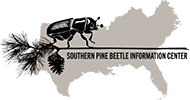Abstract
The practice of quantitatively sampling within-tree populations of Dendroctonus frontalis was investigated by comparing the relationships between sampling intensity, informational content of samples, and precision in estimation. Random and stratified random sampling plans were compared and contrasted to selective or purposeful sampling using the tree geometry model-probability density function (TG-PDF) estimation procedure. The random techniques required large quantities of data and were therefore less suitable than the TG-PDF procedure. The latter procedure incorporates knowledge of the vertical distribution of the D. frontalis life stages and therefore required much less data for a given level of precision. The TG-PDF procedure was evaluated on the basis of precision obtained in using the technique on different numbers of sample levels and the position of the sample levels. Precision as judged by the refined standard deviation of the estimate αR increased as the number of levels sampled increased. For a given number of levels, the refined αR, which associates covariables with the sample levels, always produced a better estimate than the basic standard deviation αB which assumed equal information from each sample level. Positioning of sample levels along the infested bole influenced the precision obtained. Dispersing the sample levels over the infested bole while avoiding the extremes generally resulted in better precision for each life stage. The precision in estimation was best where the informational content C of the individual levels was similar.
The optimal location for sample levels varied with the life stage being sampled. Generally 2 or 3 levels provided an adequate estimate for most sampling requirements. The emerging adult life stage was the most variable and therefore the more difficult and costly to sample.
